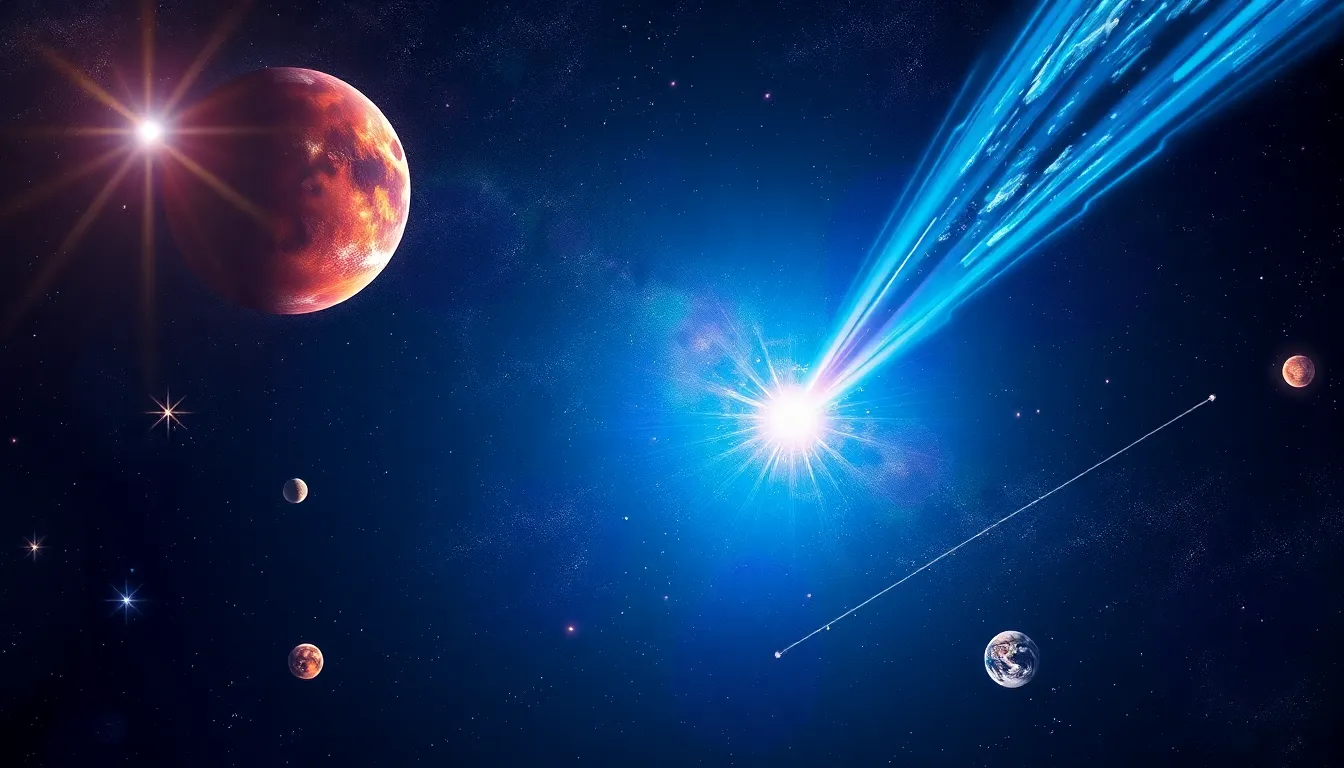Table of Contents
ToggleWhen gazing up at the night sky, it’s hard not to feel a sense of wonder. Celestial bodies twinkle like nature’s own disco ball, each one with its own story to tell. From the fiery sun to the mysterious black holes, these cosmic wonders captivate our imagination and spark our curiosity.
Overview of Celestial Bodies
Celestial bodies consist of various astronomical entities, including stars, planets, moons, asteroids, comets, and galaxies. Stars serve as luminous spheres of plasma, generating light and heat through nuclear fusion. The sun exemplifies this category, providing energy essential for life on Earth.
Planets orbit stars, showcasing diverse characteristics. Mercury, the closest planet to the sun, has a rocky surface and extreme temperature variations. In contrast, gas giants like Jupiter feature thick atmospheres and numerous moons, showcasing the diversity within planetary systems.
Moons accompany planets, with some significantly larger than their host planets. Titan, Saturn’s largest moon, possesses a dense atmosphere and lakes of liquid methane, piquing scientific interest. Many moons display unique geological features and may harbor conditions suitable for life.
Asteroids, primarily found in the asteroid belt between Mars and Jupiter, are rocky remnants from the formation of the solar system. These bodies, ranging from small boulders to large objects, provide insights into the early history of solar systems.
Comets, composed of ice and dust, originate from the outer regions of the solar system. When they approach the sun, they develop bright tails, becoming spectacular objects in the night sky. Comet Hale-Bopp, visible in the late 1990s, stands as an example of their breathtaking appearances.
Galaxies, the largest structures in the universe, contain billions of stars along with their accompanying planets and other objects. The Milky Way, our home galaxy, features a spiral shape and houses an estimated 100 to 400 billion stars. Each of these celestial bodies and structures plays a vital role in the vast cosmos, contributing to our understanding of the universe and its complex nature.
Types of Celestial Bodies

Various types of celestial bodies populate the universe, each contributing uniquely to its vastness. Understanding these entities enhances one’s appreciation of the cosmos.
Stars
Stars serve as luminous beacons in the night sky. Each star represents a massive sphere of plasma, undergoing nuclear fusion to produce light and heat. The sun, our closest star, supports life on Earth with its energy. Stars exhibit a range of sizes and temperatures; for example, red dwarfs are smaller and cooler, while blue giants are much larger and hotter. Their lifecycle varies significantly, transitioning from hydrogen-burning giants to supernovae, enriching the cosmos with heavier elements.
Planets
Planets orbit stars, displaying extraordinary diversity in their characteristics and environments. Rocky planets, like Earth and Mars, have solid surfaces while gas giants such as Jupiter and Saturn possess thick atmospheres. Mercury, the smallest planet, endures extreme temperature fluctuations due to its proximity to the sun. Beyond our solar system, exoplanets reveal a spectrum of conditions, some existing in habitable zones capable of supporting liquid water. Exploration of these worlds continues to unveil more about the potential for life beyond Earth.
Moons
Moons, orbiting planets, show remarkable variety in size and composition. Some moons, like Earth’s, are relatively small, while others, such as Ganymede, are larger than the smallest planet, Mercury. Unique geologies characterize moons; Europa, another moon of Jupiter, features a subsurface ocean that might harbor life. Titan, Saturn’s largest moon, contains lakes of liquid methane and offers enigmatic possibilities for studying prebiotic chemistry. Each moon provides insight into planetary formation and the conditions necessary for life.
Asteroids and Comets
Asteroids and comets represent remnants from the solar system’s formation, contributing to our understanding of its history. Asteroids primarily reside in the asteroid belt between Mars and Jupiter, comprised of rocky material. Their sizes range from tiny boulders to massive bodies. Comets distinguish themselves by icy cores, developing bright tails when they approach the sun. Notably, Comet Hale-Bopp dazzled observers in 1997 with its brilliant display. Studying both asteroids and comets reveals valuable information about the early solar system, including the origins of water and organic materials on Earth.
Importance of Celestial Bodies
Celestial bodies significantly influence various aspects of life on Earth and the broader universe. Understanding their roles unravels many mysteries of existence.
Impact on Earth
Celestial bodies, particularly the sun, directly affect Earth’s climate and weather systems. Sunlight drives photosynthesis in plants, forming the basis of the food chain. Planetary alignment influences gravitational forces, impacting ocean tides and geological phenomena. The moon’s gravitational pull creates tides, which regulate coastal ecosystems and marine life. Additionally, asteroids present both risks and opportunities, as impacts can shape Earth’s landscape while also providing minerals. Observations of comets and other celestial phenomena enhance tracking of potential threats, promoting planetary defense strategies.
Role in the Universe
Celestial bodies serve as essential components in the cosmic ecosystem. Stars generate light and heat, facilitating life and driving the synthesis of heavier elements during supernova events. Planets orbit these stars, creating diverse environments that might host life. Galaxies contain billions of stars, with their structures revealing insights into the universe’s evolution. Moreover, the discovery of exoplanets expands knowledge of planetary formation and the potential for extraterrestrial life. Moons enrich ecosystems and influence the conditions of their host planets, showcasing the complexity of interactions in the universe. Understanding these roles enhances comprehension of cosmic processes and our place within them.
Observing Celestial Bodies
Observing celestial bodies invites wonder and discovery. Various tools and missions enhance this exploration.
Telescopes and Technology
Telescopes serve as essential instruments for observing distant celestial bodies, expanding our understanding of the universe. Optical telescopes focus light to reveal details of planets and stars. Radio telescopes detect non-visible wavelengths, uncovering information about galaxies and cosmic events. High-tech instruments like space-based telescopes eliminate atmospheric interference, offering clearer images. Instruments such as the Hubble Space Telescope have captured stunning images of nebulae and galaxy formations. Advancements in imaging technology allow astronomers to visualize exoplanets and monitor their atmospheres. Combining multiple types of telescopes optimizes data collection, resulting in richer insights into cosmic phenomena. New technologies continue to evolve, enhancing the ability to gather data about celestial bodies effectively.
Space Missions
Space missions contribute significantly to the exploration and study of celestial bodies. Rovers like Curiosity and Perseverance explore Mars’ surface, analyzing soil and rock samples for signs of past life. Spacecraft such as Voyager have ventured beyond our solar system, providing valuable data on outer planets and interstellar space. Missions to asteroids like OSIRIS-REx collect samples for return to Earth, revealing the building blocks of our solar system. Ongoing projects, including the Artemis program, aim to return humans to the Moon, facilitating further exploration of lunar resources. International collaboration in space missions enhances knowledge-sharing and accelerates discoveries. These exploratory missions not only deepen understanding of celestial bodies but also inspire future generations to look toward the stars.
Celestial bodies captivate the imagination and deepen our understanding of the universe. Each star, planet, moon, asteroid, and comet contributes to the intricate cosmic tapestry that surrounds us. Their unique characteristics and behaviors not only inspire curiosity but also play critical roles in the dynamics of the universe.
As technology advances, the exploration of these celestial wonders continues to expand. Observations from telescopes and space missions unveil secrets that enhance our knowledge and appreciation of the cosmos. The quest to understand celestial bodies fuels scientific discovery and fosters a sense of wonder about our place in the vast universe.





